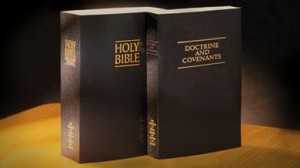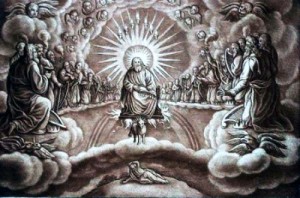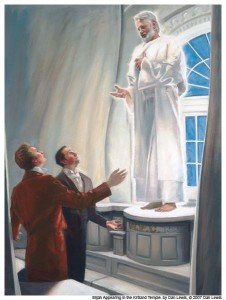Free Dictionary.com defines “divine revelation” as the “communication of knowledge to man by a divine or supernatural agency.” To expand somewhat on that definition, “divine revelation” may also be defined as God’s gift of disclosing Himself and His will to man through continuous communication of knowledge in both words and deeds. Many religions throughout the world believe that God reveals Himself to an individual or a group of individuals, and the revelations that are received are later recorded in a group of writings or sacred texts.
Much of the Restoration of the gospel through Joseph Smith involved scripture. As a significant branch of his calling, the Prophet restored the Bible to earlier purity and brought forth new holy books that no one living in his day had ever heard of. Although a book of the modern Church was revealed (the Doctrine and Covenants), most of the scriptural restoration involved records from the past. The coming forth of scriptural truths and sacred volumes formed a crucial part of the Lord’s latter-day work. [1]
Joseph Smith – Seeker of Truth
Joseph Smith, the first prophet of The Church of Jesus Christ of Latter-day Saints (inadvertently referred to as the “Mormon” Church by the media and others) was a seeker of truth. He was raised in a deeply religious family, and when the time came for him to be baptized, this young man of 14 years of age had to make a decision as to which of the many Christian denominations to join.
During this period there was great religious upheaval in the area where Joseph and his family lived. Ministers of various denominations literally competed against one another in an effort to add as many of the populace to their flock as possible. As a result, there was a great matter of confusion on the doctrines that were being taught, as one denomination taught one thing, and another denomination taught another. For a boy as young as Joseph Smith, trying to decide which of the Churches were true became very difficult. He later wrote.
So great were the confusion and strife among the different denominations, that it was impossible for a person young as I was [ … ] to come to any certain conclusion who was right and who was wrong [ … ] In the midst of this war of words and tumult of opinions, I often said to myself: What is to be done? Who of all these parties are right; or, are they all wrong together? If any one of them be right, which is it, and how shall I know it? (Joseph Smith-History 1:8, 10).
One day he came across a verse of scripture in the Bible, James 1:5, which reads, “If any of you lack wisdom, let him ask of God, that giveth to all men liberally, and upbraideth not; and it shall be given him.” And so, being a seeker of wisdom and truth, he took the matter before the Lord in earnest prayer. In response to his humble prayer, he was told that none of the churches on the earth had the fullness of the truth. In time, God called Joseph to be a prophet, to re-establish the Church of Jesus Christ, and to restore the priesthood (the authority given to men to act in God’s name).
He was led by God to an ancient record and given the ability to translate it into English. This record is called the Book of Mormon. He continued to pray and receive revelation for the Church throughout his life. These revelations were compiled into a book of scriptures referred to as the Doctrine and Covenants and shows that God still leads His children today. [2]
The Church of Jesus Christ of Latter-day Saints was formally organized on 6 April 1830.
Revelation and Scriptural Restoration
Among the important events of the Restoration was a series of encounters Joseph Smith had with scripture, most often involving the Bible. Each of those encounters contributed in its way to the bringing forth of gospel light, and each continues to bless the Church today, in some ways even more so now than in the early days of the Restoration. . . . Even more to the point, the Restoration not only touches on every biblical doctrine but also dramatically improves upon the Bible’s presentation of every doctrine. . . . As good and as important as the Bible is—an assessment Joseph Smith maintained throughout his life—it alone is not sufficient to answer all gospel questions. [3]
As aforementioned, the revelations that were received by Joseph Smith pertaining to the restored gospel were compiled into a volume of scripture known as the Doctrine and Covenants. The Doctrine and Covenants differs in that although it is a scriptural book, it was not a restored book of scripture like the Book of Mormon, but rather it is modern scripture. Nevertheless, it is still a vital part of the restoration of ancient scripture. The revelations contained within the Doctrine and Covenants were indeed another encounter with the Bible for Joseph Smith in that most of the revelations expound on doctrinal themes that can be found in both the Old and New Testaments of the Holy Bible. The revelations in the Doctrine and Covenants help to enhance our understanding of each of those Biblical themes through clarifying words in the voice of the Lord Himself, thus teaching us more than can be found in the Bible passages.
Consider the following Doctrine and Covenants topics, among many others that could be listed: God the Father, Jesus Christ, and the Holy Ghost; or faith, repentance, baptism, the gift of the Holy Ghost, justice, mercy, the Fall, the Atonement, the Resurrection, and the last judgment; or covenants, temples, ordinances, spiritual gifts, tithing, the Church, missionary work, angels, Satan, temptation, the last days, the Second Coming, and the Millennium. [3]
Some of the revelations within the Doctrine and Covenants deal specifically with passages or events from the Bible. For example, Section 45 can be compared to the Olivet Discourse recorded in Matthew 24 with clarification added for better understanding. As the Savior often taught in parables, section 86, for example, sheds new light on the parable of the wheat and the tares as recorded in Matthew 13, as well as, gives an exposition on the words of the prophet Isaiah. There are s few sections that are in question and answer format, such as section 77 answers questions that Joseph Smith had concerning the book of Revelation, and section 113 answers questions that he had concerning the teachings of Isaiah. In section 132, responses are given to questions about marriage that were raised during the Bible translation. In section 65, we learn that which Daniel saw as “the stone [which] was cut out of the mountain without hands” (Daniel 2:45) refers to The Church of Jesus Christ of Latter-day Saints. Section 7 is a revelation concerning the mission of the Apostle John, and sections 46 and 74, expand on verses found in the New Testament book of 1 Corinthians.
Section 76 is a grand enlargement of a statement of Jesus in John 5. Section 84 provides new insights into the lives of Moses and Jethro (among others), and it sheds dramatic new light on the history of the priesthood in Old and New Testament times. Similarly, section 107 reveals things about Adam, Enoch, Melchizedek, and other patriarchs that are entirely unknown in the Bible. [3]
And, section 110 records the actual visits to Joseph Smith of three persons discussed throughout the Bible – Jesus, Moses, and Elijah.
The Doctrine and Covenants Enhances Understanding of Biblical Passages
In Paul’s letter to the Corinthian Church, as recorded in 1 Corinthians 15:40-42, we learn:
There are also celestial bodies, and bodies terrestrial: but the glory of the celestial is one, and the glory of the terrestrial is another. There is one glory of the sun, and another glory of the moon, and another glory of the stars: for one star differeth from another star in glory. So also is the resurrection of the dead. It is sown in corruption; it is raised in incorruption.
Clarification of these scriptures can be found in modern day revelation as given to Joseph Smith, and is recorded in section 76 of the Doctrine and Covenants. In Doctrine and Covenants 76:50-70, the glory and reward of exalted beings in the celestial kingdom is described; in Doctrine and Covenants 76:71-80, those who will inherit the terrestrial kingdom are described; and in Doctrine and Covenants 76:81-113, the status of those in the telestial, terrestrial, and celestial glories (known as the Three Degrees of Glory) is explained.
Section 76 in the Doctrine and Covenants tells us more about heaven than all the rest of known scripture put together. Surely Paul saw the same sort of vision, and when mentioning the Celestial, Terrestrial, and Telestial glories, may have done more than that. He may have expounded the way Section 76 does, but the account is missing from the Bible and has been restored by Joseph Smith through revelation. This section of the Doctrine and Covenants alone brings joy to anyone who reads it, and is another witness that God lives and Jesus is the Christ.
Mysteries of the Book of Revelation Explained
While translating the Scriptures, the Prophet Joseph Smith received from God an explanation of the Revelation of St. John. Some of the questions which he asked and received answers to include the following, which are recorded in Doctrine and Covenants section 77:
Q: What is the sea of glass spoken of by John, 4th chapter, and 6th verse of the Revelation?
A: It is the earth, in its sanctified, immortal, and eternal state.
Q: What are we to understand by the four and twenty elders, spoken of by John?
A: We are to understand that these elders whom John saw, were elders who had been faithful in the work of the ministry and were dead; who belonged to the seven churches, and were then in the paradise of God.
Q: What are we to understand by the book which John saw, which was sealed on the back with seven seals?
A: We are to understand that it contains the revealed will, mysteries, and the works of God; the hidden things of his economy concerning this earth during the seven thousand years of its continuance, or its temporal existence.
Q: What are we to understand by the seven seals with which it was sealed?
A: We are to understand that the first seal contains the things of the first thousand years, and the second also of the second thousand years, and so on until the seventh.
Q: What are we to understand by the four angels, spoken of in the 7th chapter and 1st verse of Revelation?
A: We are to understand that they are four angels sent forth from God, to whom is given power over the four parts of the earth, to save life and to destroy; these are they who have the everlasting gospel to commit to every nation, kindred, tongue, and people; having power to shut up the heavens, to seal up unto life, or to cast down to the regions of darkness.
Q: What are we to understand by the angel ascending from the east, Revelation 7th chapter and 2nd verse?
A: We are to understand that the angel ascending from the east is he to whom is given the seal of the living God over the twelve tribes of Israel; wherefore, he crieth unto the four angels having the everlasting gospel, saying: Hurt not the earth, neither the sea, nor the trees, till we have sealed the servants of our God in their foreheads. And, if you will receive it, this is Elias which was to come to gather together the tribes of Israel and restore all things.
Q: What are we to understand by sealing the one hundred and forty-four thousand, out of all the tribes of Israel—twelve thousand out of every tribe?
A: We are to understand that those who are sealed are high priests, ordained unto the holy order of God, to administer the everlasting gospel; for they are they who are ordained out of every nation, kindred, tongue, and people, by the angels to whom is given power over the nations of the earth, to bring as many as will come to the church of the Firstborn.
Promises Fulfilled
In Doctrine and Covenants 110:13-16 we learn of the fulfillment of the promises of the Old Testament Malachi when Elijah returns and commits the keys of his dispensation. This vision was manifested to Joseph Smith and Oliver Cowdery in the Kirtland Temple in Kirtland, Ohio on 3 April 1836:
After this vision had closed, another great and glorious vision burst upon us; for Elijah the prophet, who was taken to heaven without tasting death, stood before us, and said:
Behold, the time has fully come, which was spoken of by the mouth of Malachi—testifying that he [Elijah] should be sent, before the great and dreadful day of the Lord come—
To turn the hearts of the fathers to the children, and the children to the fathers, lest the whole earth be smitten with a curse—
Therefore, the keys of this dispensation are committed into your hands; and by this ye may know that the great and dreadful day of the Lord is near, even at the doors.
The Doctrine and Covenants is an indispensable key to understanding many of the passages recorded in the Bible. Without the Doctrine and Covenants, the restoration of the scriptures would be incomplete.



